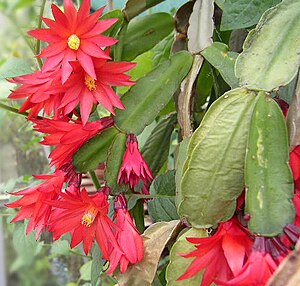Hatiora
| Hatiora | ||||||||||||
|---|---|---|---|---|---|---|---|---|---|---|---|---|

|
||||||||||||
| Systematics | ||||||||||||
|
||||||||||||
| Scientific name | ||||||||||||
| Hatiora | ||||||||||||
| Britton & Rose |
Hatiora is a genus of plants fromthe cactus family (Cactaceae). The botanical name honors the English mathematician, astronomer and explorer Thomas Hariot and is an anagram of his name.
description
The species of the genus Hatiora grow epiphytically or lithophytically . They are bushy and richly branched. Your initially upright and later spreading or overhanging or hanging shoot sections are limited in their length growth. The cylindrical, winged, angular or flattened shoot sections are up to 5 centimeters long. They arise individually or in groups from the areoles at the tip of older shoot sections. Areoles capable of flowering are at the end of the shoot sections and flow together there. Thorns are missing or are designed as soft bristles
The radial symmetry, bell-shaped, yellow, pink or red flowers appear at the shoot tips and open during the day. Your bald pericarpel is angular, winged or round. The flower tube is short.
The small, spherical fruits are bare. They contain brown or black seeds 1 millimeter in length.
distribution
The genus is common in southeastern Brazil .
Systematics
The first description of the genus as Hariota was published in 1834 by Augustin-Pyrame de Candolle . According to the rules of the International Code of Botanical Nomenclature , however, this name is invalid, since Michel Adanson gave this name to a genus as early as 1763. Nathaniel Lord Britton and Joseph Nelson Rose formed the anagram Hatiora from the original name of the genus in 1915 . The type species of the genus is Hatiora salicornioides .
The genus is divided into two sub-genera. The subgenus Hatiora is characterized by rotating or cylindrical, never ribbed shoot sections and a pericarpel with a round cross-section . The Rhipsalidopsis has flattened shoot sections and an angular or winged pericarpel. The genus includes the following species:
- Subgenus Hatiora
- Hatiora herminiae (Porto & Castell.) Barthlott
- Hatiora salicornioides (Haw.) Britton & Rose
- Subgenus Rhipsalidopsis (Britton & Rose) Barthlott
-
Hatiora epiphylloides (Porto & Werderm.) Buxbaum
- Hatiora epiphylloides subsp. epiphylloides
- Hatiora epiphylloides subsp. bradei (Porto & A.Cast.) Barthlott & NPTaylor
- Hatiora gaertneri (rule) Barthlott
-
Hatiora epiphylloides (Porto & Werderm.) Buxbaum
and Hatiora × graeseri Barthlott ex DRHunt - the so-called “Easter cactus” - a hybrid of Hatiora gaertneri and Hatiora rosea .
Synonyms of the genus are Hariota DC. (1834, nom. Illeg. ICBN -Article 53.1), Rhipsalidopsis Britton & Rose (1923), Epiphyllopsis A. Berger (1929) and Pseudozygocactus Backeb. (1938).
proof
literature
- Edward F. Anderson : The Great Cactus Lexicon . Eugen Ulmer KG, Stuttgart 2005, ISBN 3-8001-4573-1 , p. 341-343 .
Individual evidence
- ↑ Lotte Burkhardt: Directory of eponymous plant names . Extended Edition. Botanic Garden and Botanical Museum Berlin, Free University Berlin Berlin 2018. [1]
- ↑ Augustin-Pyrame de Candolle: Mémoire sur quelques espèces de cactées, nouvelles ou peu connues . Treuttel & Würtz, Paris 1834, p. 23 ( online ).
- ↑ Michel Adanson: Familles des Plantes . Volume 2, Paris 1763, p. 243 ( online ).
- ↑ In: LH Bailey: Standard Cyclopedia of Horticulture . P. 1432, New York 1915
- ^ Edward F. Anderson : The great cactus lexicon . Eugen Ulmer KG, Stuttgart 2005, ISBN 3-8001-4573-1 , p. 341 .